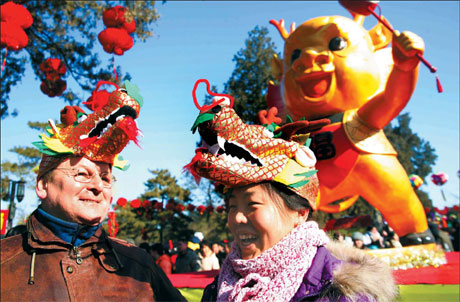
A foreign tourist and a local resident share a light moment at the Ditan Park Temple Fair in Beijing on Tuesday. Chen Xiaogen / For China Daily
It is the symbol of the nation and of potent and auspicious powers. It has control over water, rainfall, hurricane and flood. It is also the symbol of good luck. Chinese people have revered it for thousands of years. And this is its year in the Chinese zodiac, the Year of the Dragon. At the beginning of every Chinese lunar year, Chinese people both at home and abroad play with this mythical creature. They carry it on bamboo sticks in parades on streets, carve its head on boats which they race on rivers, lakes and even seas, have named a type of noodle after its beard and perform a dance named after it.
"A dragon has lots of auspicious meanings; it's the harbinger of happiness and good fortune and has sublime connections to imperial power and Chinese nationality," says Li Xu, director of Zhangjiang Museum and curator of a dragon theme show at Lifehub@Jinqiao, a shopping mall in Shanghai's Pudong New Area.
"Many people believe playing with a dragon brings good fortune," Li says. "Chinese people have spread the 'dragon cult' across the whole world and made people outside China realize that the Chinese dragon, or long, is not the fierce, fire-breathing vile monster of the West." It is a benevolent creature and legendary protector of people.
While the dragon boat race is held in early summer, or on the fifth day of the fifth lunar month, and dragon beard noodle is served in early spring, or on the second day of the second lunar month, the dragon dance is the most important event of the lunar new year. Across the world, Chinese communities celebrate Spring Festival, the first day of the Chinese lunar calendar, with firecrackers, jiaozi (dumplings filled with meat and vegetables) and dragon and lion dance.
So popular has dragon dance become among Chinese, both at home and abroad, that international competitions, guided by well-compiled rulebooks, are now a regular affair. The winners get to win trophies, gold medals and great honors.
One of the places to look for famous dragon dancers in Shanghai is 147 Donglin Street in Sanlin in the Pudong New Area. The place has an exhibition of photographs, videos, trophies and certificates of dragon and lion dance champions. Sanlin has won fame for dragon and lion dance performances. Its teams, comprising farmers from Sanlin, have performed at the opening ceremony of the Shanghai 2010 World Expo, and the anniversary celebrations to mark the return of Hong Kong and Macao to China.
The township has hosted four international dragon and lion dance competitions, and its performers have won many international awards. "Dragon dance started in ancient times as part of the ceremony to pray for a good harvest and prosperity, and gradually developed into a celebration," says Lu Dajie, head of the Dragon Lion Association of Shanghai. "Now it's a form of entertainment enjoyed by Chinese all over the world, and a type of game recognized by the Olympic Council of Asia."
Lu, 63, has written some of the rules that are followed in international dragon dance competitions. Lu was born in a farmer's family and, as a child, used to follow dragon dancers along the streets of Sanlin trying to imitate their moves and nuances along with other boys.
The passion was to change his life. "I was an amateur choreographer and director of folk dance in the 1980s, when I combined dragon and lion dance in a formal dance show with drum and gong music." So successful was the farmer-turned-choreographer's composition that he did further and in-depth research into folk dance to become a real expert in dragon and lion dance.
"At first it was a parade with dancers down the streets with five to nine people holding a mock dragon on bamboo sticks and making simple movements to imitate a moving dragon," he says.

Copyright ©1999-2011 Chinanews.com. All rights reserved.
Reproduction in whole or in part without permission is prohibited.